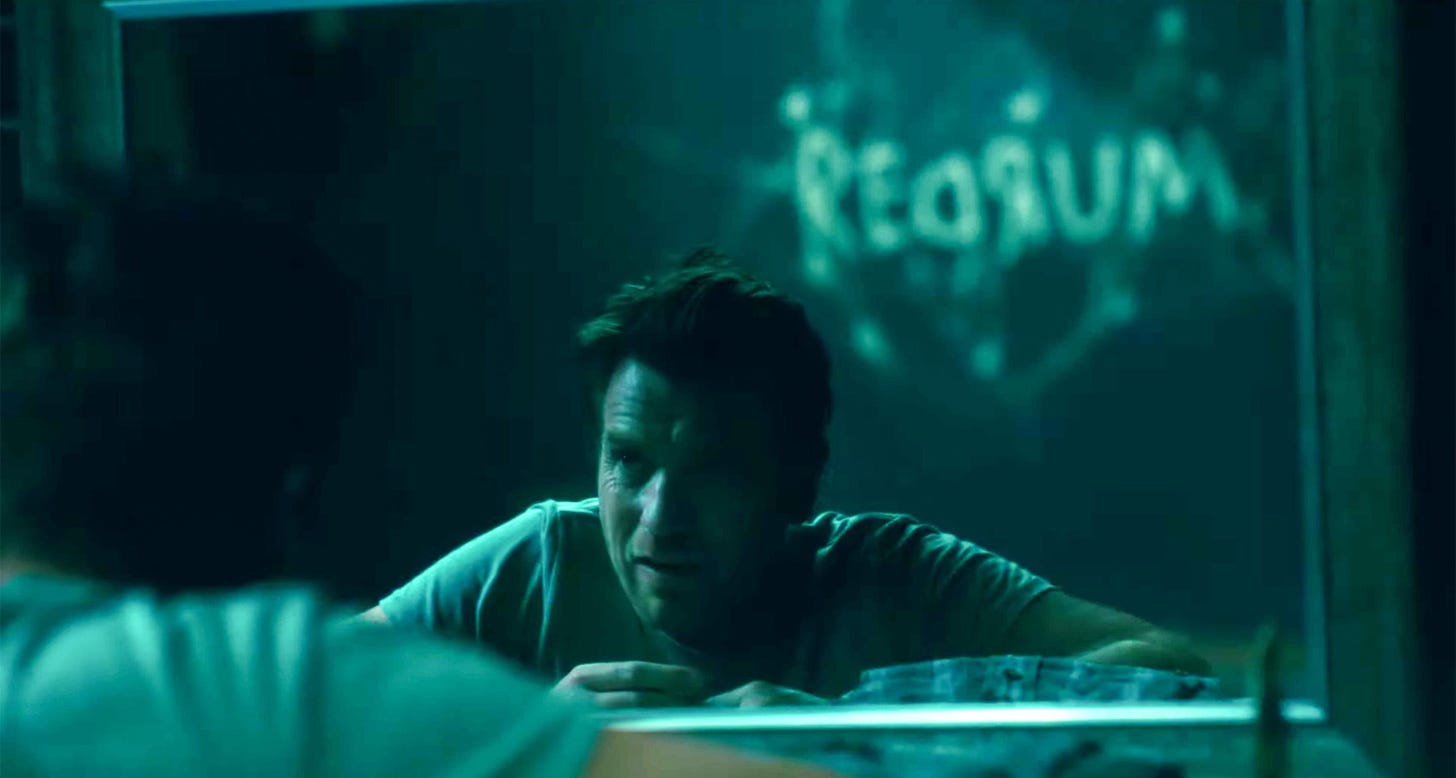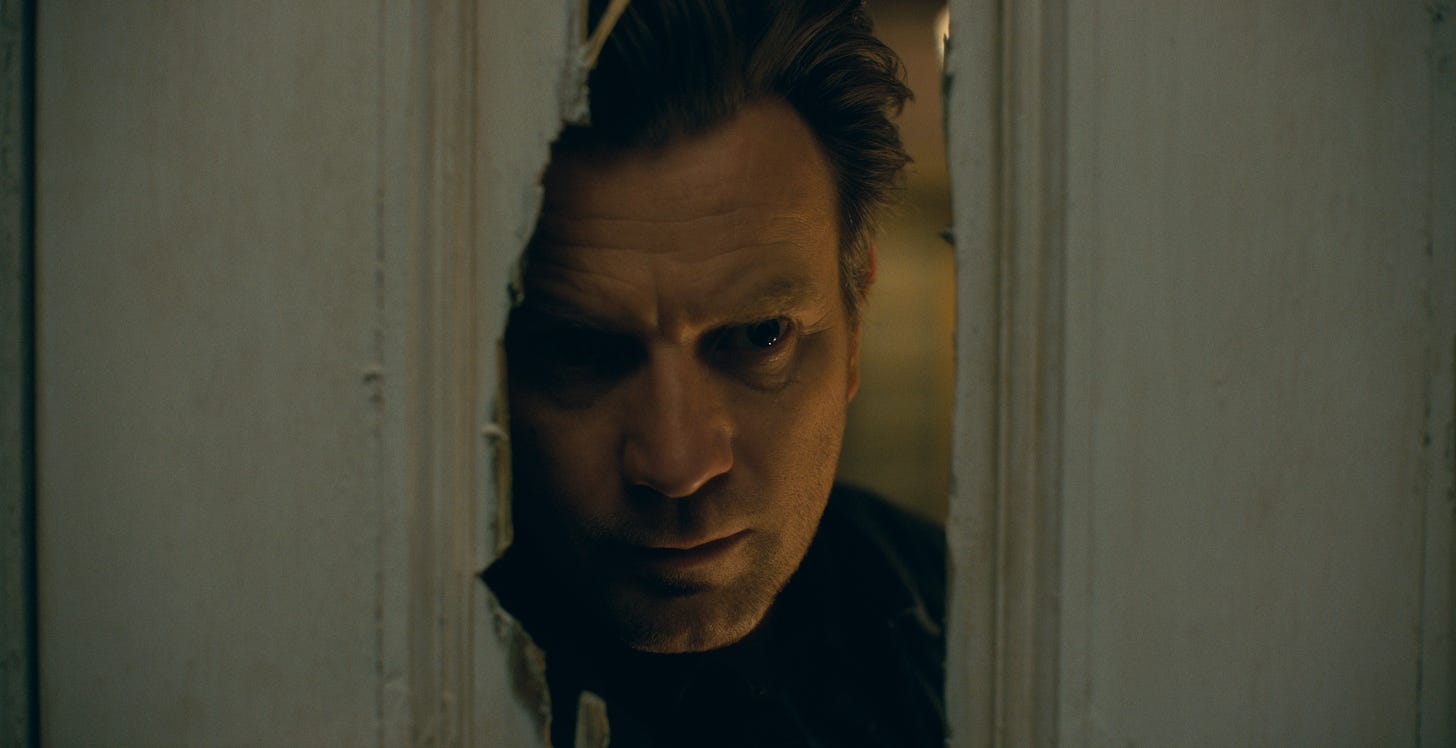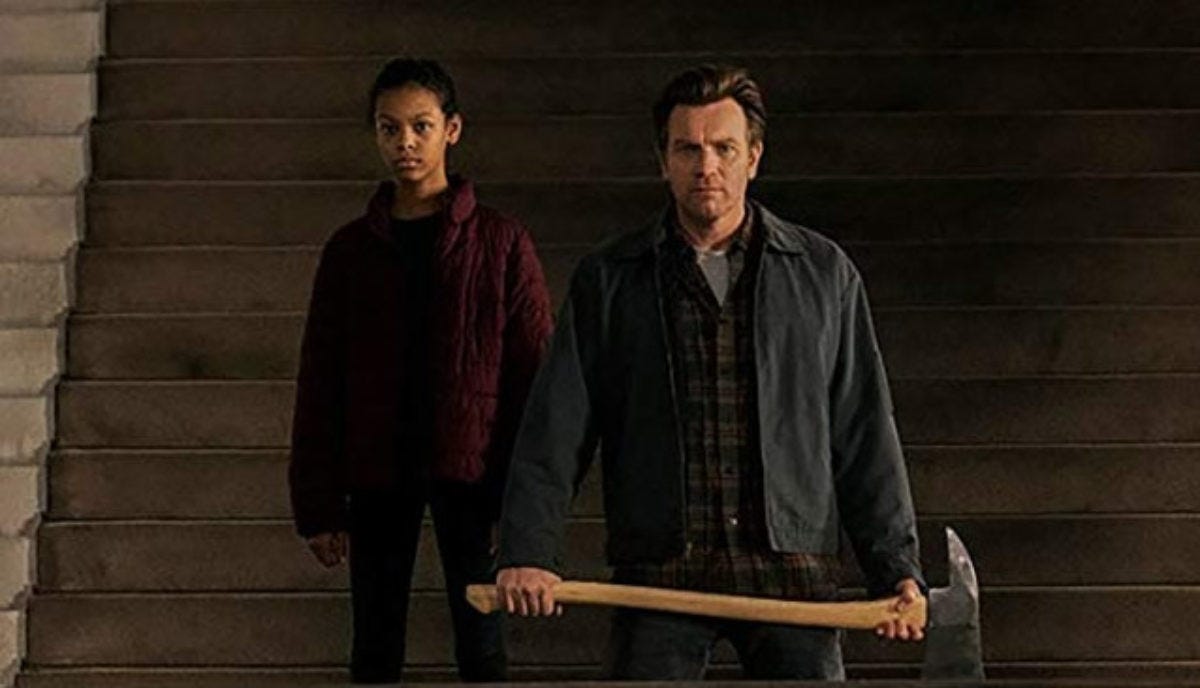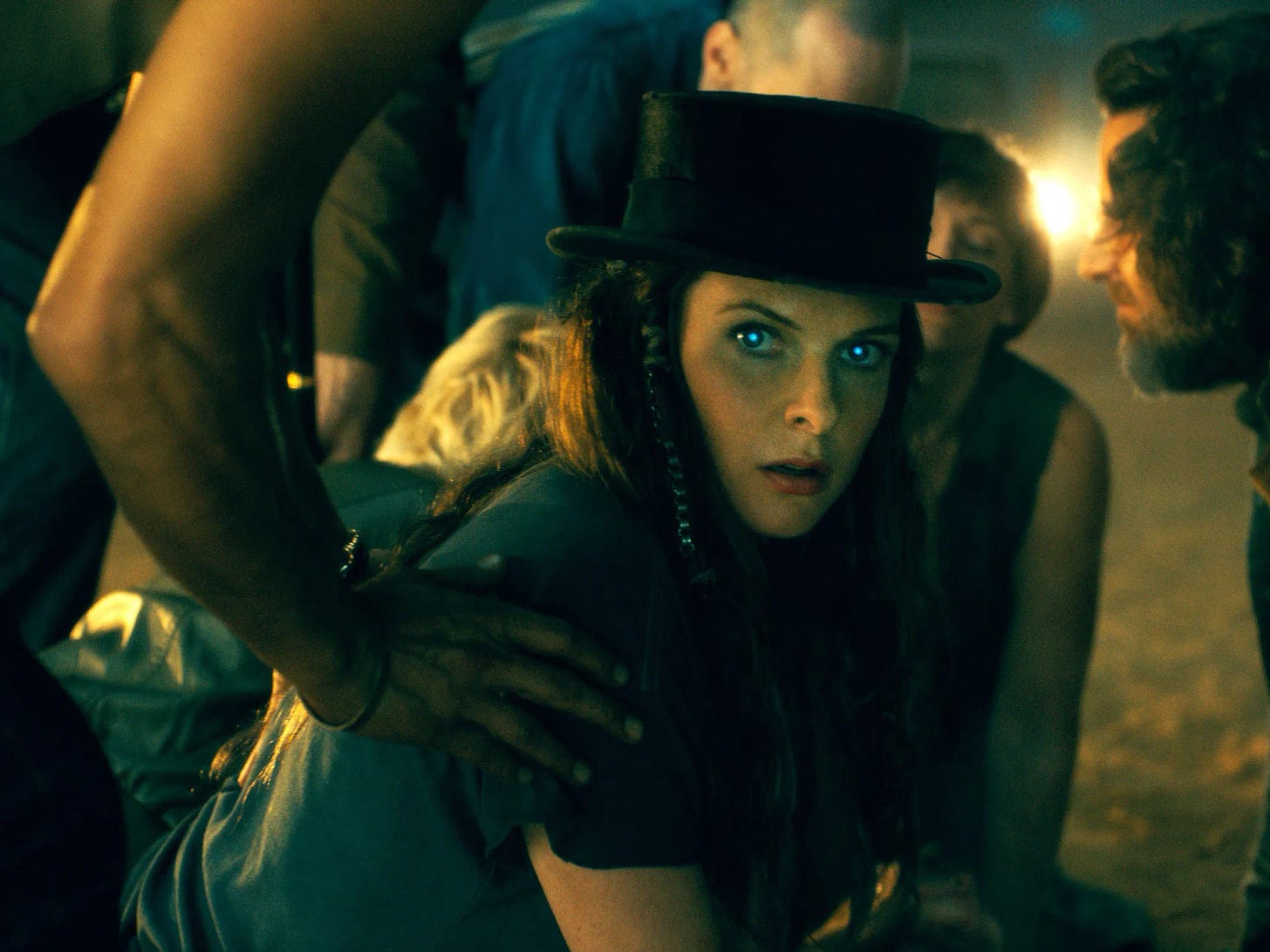Redrum Revisited: 'Doctor Sleep' and the Problem of the Impossible Sequel
The ghosts of another movie haunt Mike Flanagan's adaptation of Stephen King's sequel to 'The Shining.' That it almost works anyway is kind of remarkable.
At the onset of the final act of Mike Flanagan’s 2019 film Doctor Sleep, the now-grown Dan Torrance returns to the decaying remains of the long-abandoned Overlook Hotel, the once-glamorous Rocky Mountain resort where, as a boy, he’d experienced a lifetime’s worth of terror in The Shining. After prying open the entrance, Dan (now played by Ewan McGregor) walks into the lobby with the grim determination of a man embracing the inevitable. Like the film in which he’s appearing, Dan was always fated to come back here, whether it was good for him or not.
Both an adaptation of Stephen King’s 2013 sequel to his 1977 novel The Shining and a continuation of Stanley Kubrick’s 1980 adaptation of the same, Doctor Sleep is a Kobayashi Maru of a movie. It was always an impossible undertaking certain to end in failure. It was only a matter of what path it takes to get there. That it comes this close to working anyway is kind of remarkable, a credit to Flanagan’s skills as a writer and director, thoughtful performances from McGregor and his young co-star Kyliegh Curran, and a let’s-go-for-it villain turn by Rebecca Ferguson. If, in the end, they can’t quite bring it all together, there’s a kind of nobility in making the best possible version of a movie that was never going to work.
Like the Overlook itself, it’s a construction inhabited by ghosts, a film haunted by both its literary and cinematic predecessors. That these ghosts are seemingly incompatible doesn’t help. In a featurette accompanying the film on its home video release, Flanagan refers to there being “two visions of The Shining that seemed to be in competition within the minds and hearts of a lot of fans: the Stephen King Shining and the Kubrick Shining. The two are very different things.”
King has famously been grouchy about the Kubrick film since its release, and if that (now) puts him out of step with most of the world, it’s not hard to see why. The novel is, at heart, a psychological drama about alcoholism and artistic frustration combining to turn a man against his family (with some supernatural help). It plunges deep into the ugly psyche of Jack Torrance—who shares King’s New England origins and early history of placing short stories in men’s magazines while working as a teacher—as he tries and fails to shake off his destruction urges. Kubrick’s film, though largely faithful to the novel’s plot in the broad strokes, keeps its distance. Its horror comes not from drawing viewers into Jack’s mind but from watching from a distance as he disintegrates within the Overlook’s cavernous, uncaring walls. Flanagan’s film doesn’t really try to split the difference. Instead, it hews close to the plot and tone of its source novel. That makes it ultimately run into the same trouble as King’s book, but not for a while.
As a novel, Doctor Sleep has all the markings of King’s later work. It’s not particularly scary and reprises familiar themes, but it’s rich in characters, lore, and local detail and remains a consistently compelling read even when the narrative meanders or lingers on a single place longer than the King of an earlier era would let it. Perhaps most significantly, its take on addiction—which, as in The Shining, quickly emerges as its central subject—is the work of a writer on the other side of its clutches. The King who wrote The Shining was so in thrall to substance abuse, he would produce whole books with no memory of writing them. The King of Doctor Sleep is the one who’d twelve-stepped away from those problems but never forgot them.
It makes a certain amount of autobiographical sense, then, that Dan Torrance would develop his father’s own problems but learn how to fight them via Alcoholics Anonymous, emerging as a better and more empathetic figure in the process. Flanagan’s film follows him on that journey. Though he learns—thanks to the ghost of Dick Hallorann (Carl Lumbly)—to imprison the ghosts that have followed him from the Overlook as a child, he falls into a peripatetic existence of drinking and fighting. Flanagan’s film introduces the adult Dan as he finds his bottom, stealing money from a one-night-stand as she sleeps off a night of booze and coke and leaving her toddler beside her nude body and a pile of vomit. Later, his extrasensory powers will reveal their grim fate (and, shades of Trainspotting, give McGregor another chance to play opposite a grotesque child corpse). Clearly, he has to clean up his act.
After finding the help of sober friends and attending years of AA meetings later, Dan has done just that, serving as an orderly with a gift for comforting the soon-to-die in a hospice located in the New Hampshire town he’s come to call home, earning the “Doctor Sleep” nickname in the process. It’s here he also remotely befriends Abra (Curran), a young girl with supernatural gifts similar to, but even more powerful than, his own. They correspond via blackboard messages they create with their minds, but when Abra psychically witnesses the murder of a child (Jacob Tremblay) kidnapped on his way back from a baseball game, she decides to seek out Dan in person. The kid, she tells him, has fallen victim to a wandering group called The True Knot that feeds on the “steam” produced by tormenting and killing those with psychic gifts.
If all this sounds only loosely tied to The Shining, that’s because it is.* For much of its running time, Doctor Sleep plays like a different kind of adaptation of a different sort of King novel. Remove Hallorann and early scenes depicting events of The Shining and their immediate aftermath and it remains a compelling story—and the sort of story Flanagan tells well. The heart of the film alternates between depicting Dan and Abra’s growing bond as it becomes increasingly clear that only they stand between the True Knot and disaster. Yet the film, like the book, brings a disarming amount of sympathy to its villains via scenes of the True Knot’s vagabond murder caravan. Sure, they live off murdered children, but they’re also a functional family unit made up of misfits with nowhere else to go. As the True Knot’s second-in-command, Zahn McClarnon provides quiet ballast to Ferguson’s spirited, seductive turn as Rose the Hat. (So called because of her memorable hat. It’s pretty simple.) For much of its running time, Doctor Sleep resembles The Shining most often in its understanding that horror villains sometimes need to chew on the scenery, but even when practically licking her lips before a kill, Rose retains a certain vulnerability.
Flanagan has a gift for complex, troubled characters and for creating eerie atmospheres that threaten to give way to frightful chaos, and often do. Those skills allowed him to prove himself one of the most thoughtful of King’s adapters with Gerald’s Game (no easy feat given that it revolves around a woman bound to a bed for much of its running time). It’s not hard to see traces of King in the films and TV series he made both before and after Doctor Sleep (and he has another King adaptation, Life of Chuck, in the works). He’s the right director for this job.
The problem is the job itself. As the film unfoldsm Dan and Abra move toward a direct confrontation with The True Knot. The climax of this confrontation takes place at the Overlook (the grounds of its ruins in the novel but the hotel itself in the film) where Dan believes he can channel the psychic energy of the place against Rose. Or something. The Overlook connection seems forced. But where a film with no ties to The Shining would be free to opt for a different kind of finale, the Overlook is the fireworks factory promised by the existence of a sequel to The Shining.
Is there any way that the destination could live up to the build-up? If so, Doctor Sleep doesn’t find it. Its return to the Overlook is skillfully done and hits all the expected stops—Room 237, the Colorado Lounge, the Gold Room, etc.—but it can’t help but feel perfunctory. Dan’s encounter with the ghostly Jack, who’s now taken Lloyd’s place behind the bar, encapsulates what doesn’t work. Taking over for Jack Nicholson, Henry Thomas (a member of what’s become Flanagan’s stock company) is quite good. But Nicholson’s performance is so burned into collective conscience that it can’t help but feel off. The Overlook scenes find Doctor Sleep surrendering originality in the service of another film’s greatest hits.
That doesn’t make it a bad movie. It’s not (and the director’s cut is even better). But it does make it a frustrating one. There are so many other films built around past works and familiar characters that don’t work nearly as well as Doctor Sleep, but the film still ends up sharing some of the same problems as, say, David Gordon Green’s Halloween films (to choose an example more or less at random): We’ve seen this before. Why not show us something else?** When Doctor Sleep underperformed at the box office, some pundits blamed it on audiences not caring, or even knowing, about an old movie like The Shining. But maybe the film had a different problem: they did.
In the end, Flanagan’s film gives the Overlook the fiery ending King penned for it but Kubrick rejected. Viewed generously, it’s a pointed gesture. Doctor Sleep may not escape the shadow of its past, but it scorches the earth for anyone else who might try.
* Which isn’t to say it’s not tied to it at all, or to the greater Stephen King mythos. At one point Hallorann tells Dan “Ka’s a wheel, Doc,” an Easter Egg for King readers likely to baffle others.
** That Doctor Sleep arrived after Ready Player One also took a trip to the Overlook didn’t help.








🎶 They call me Doctor Sleep / Good morning, how are you, I'm Doctor Sleep 🎶
I liked this well enough when I saw it in 2019, but I can honestly say I’ve never once considered going back and watching it a second time. As unnecessary sequels go, you can do a lot worse than Flanagan’s DOCTOR SLEEP, but I’d much rather see him tackle something that hasn’t been picked over already.